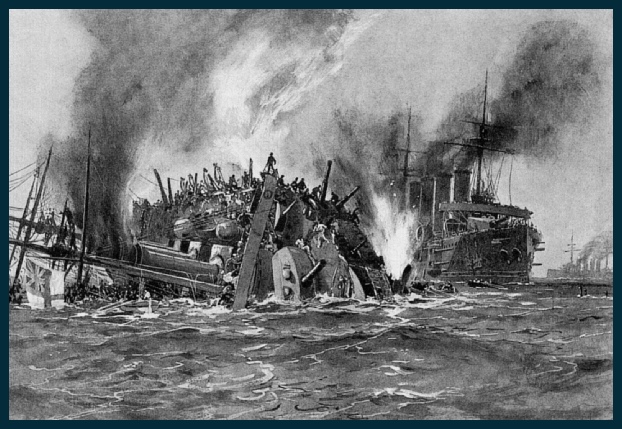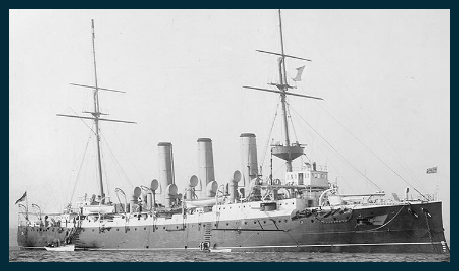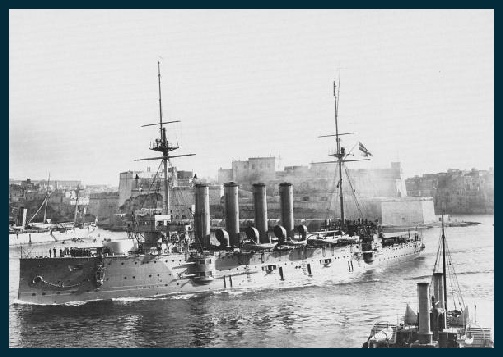Copyright © All rights reserved.



George Sollitt

On the morning of 22 September, Aboukir and her sisters, Cressy and Hogue, were on patrol without any escorting destroyers as they had been forced to seek shelter from bad weather. The three sisters in line abreast, about 2,000 yards (1,800 m) apart, at a speed of 10 knots (19 km/h; 12 mph). They were not expecting submarine attack, but they had lookouts posted and had one gun manned on each side to attack any submarines sighted. The weather had moderated earlier that morning and Tyrwhitt was en route to reinforce the cruisers with eight destroyers.
U-
As Hogue approached her sinking sister, the ship's captain, Wilmot Nicholson, realized that it had been a submarine attack and signalled Cressy to look for a periscope although his ship continued to close on Aboukir as her crew threw overboard anything that would float to aid the survivors in the water. Having stopped and lowered all her boats, Hogue was struck by two torpedoes around 06:55. The sudden weight loss of the two torpedoes caused U-
Cressy attempted to ram the submarine, but did not hit anything and resumed her rescue efforts until she too was torpedoed at 07:20. She too took on a heavy list and then capsized before sinking at 07:55. Several Dutch ships began rescuing survivors at 08:30 and were joined by British fishing trawlers before Tyrwhitt and his ships arrived at 10:45. The combined total from all three ships was 837 men rescued and 62 officers and 1,397 enlisted men lost. Of these, Aboukir lost a total of 527 men. Among these was George, his body was never recovered and he is commemorated on the Naval Memorial at Chatham
The disaster shook public opinion in Britain, and the reputation of the Royal Navy worldwide. The surviving cruisers were withdrawn from patrol duties; Admiral Christian was reprimanded, and Drummond, who did not survive, was criticized by the resulting Inquiry for failing to take the anti-
By contrast, Weddigen and his crew returned to a hero's welcome; Weddigen was awarded the Iron Cross, 1st class, while his crew each received the Iron Cross, second class. The reputation of the U-
In 1954 the British government sold the salvage rights to all three ships to a German company and they were subsequently sold again to a Dutch company which began salvaging the wrecks' metal in 2011. There has been a good deal of diving on the site -
George died on 22nd September 1914 and is commemorated in St Leonard’s Church and on the Town Memorial.
George William Sollit was born on 2nd December 1875 in Norton and his birth was registered in Malton. He was the eldest son of William and Ruth (nee Sanderson) Sollitt, who married in the Malton area in the last quarter of 1875.
In 1881 the family were living in Gages Lane, off Town Street in Old Malton. William was working as a labourer in a brewery, either at the Crystal Brewery just by County Bridge or Russell’s Brewery which was where Morrison’s now is.
1881 Census – resident at Town Street, Gages Lane, Old Malton
SOLLITT, William, Head, Married, M, 29, Brewers Labourer, Norton Yorkshire,
SOLLITT, Ruth, Wife, Married, F, 22, , Old Malton Yorkshire,
SOLLITT, George W, Son, Single, M, 5, , Norton Yorkshire,
SOLLITT, Alice, Daughter, Single, F, 3, , Norton Yorkshire,
SOLLITT, Charlotte, Daughter, Single, F, 1, , Norton Yorkshire,
By 1891 the family had moved to Great Ouseburn and George had been promoted to Foreman Brewster, but George had left home.
1891 Census – Resident at Langthorpe, Great Ouseburn, Yorkshire, England
William, Sollett, Head, Married, Male, 39, Foreman Maltster, Malton, Yorkshire, England
Ruth, Sollett, Wife, Married, Female, 31, -
Alice, Sollett, Daughter, -
Alfred, Sollett, Son, -
Maud, Sollett, Daughter, -
Rose, Sollett, Daughter, -
Mary, Sollett, Daughter, -
He was presumably on his way south to Chatham where he started his service in the Royal Navy on 24th June 1891 as Boy (2nd Class) on HMS Caledonia, a second-
After a while ashore at shore bases Pembroke and Wildfire, George joined HMS Blenheim, a cruiser on the Channel Station in January 1896. During his time on her, HMS Blenheim was sent to the Canary Islands to re-


From 1901 to 1904 he served on HMS Pegasus, a Pelorus Class protected cruiser commissioned in 1901 for the Mediterranean Station. The class proved thoroughly unsatisfactory and they were all condemned in 1904, presumably why George left her at that time, but they were reprieved and Pegasus finally was sunk during World War 1.
In 1905 having served his twelve year contract he joined the Royal Fleet Reserve at Chatham, and in the first quarter of 1908 he married Annie Watson in the Malton area.
However he re-
